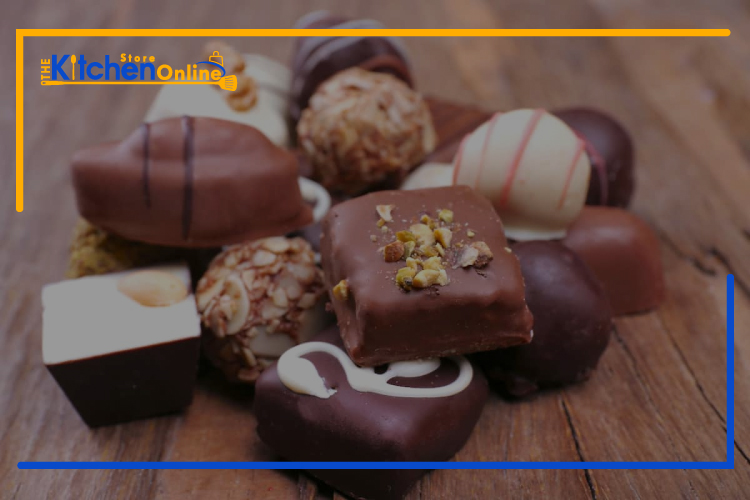Nearly everyone loves chocolate.
Most people can’t keep chocolate on hand for very long, but if you’re super-willing, buy in bulk, or carry chocolate at all times, make sure the stash is safe.
Can chocolate get moldy? No, dried chocolate can’t grow mold. A stale product can “bloom” if it’s not stored properly. Despite its high moisture content, chocolate sauce and syrup are unlikely to cause mold growth.
As we’ll show you in this article, we’ll analyze the freshness and quality of your chocolate and provide information about how to keep it at its tastiest for the longest amount of time.
You’ll even get tips for reviving chocolate that’s been damaged.
Can Chocolate Grow Mold?
Mold cannot grow on chocolate due to its low moisture content.
Moisture is the only thing bacteria require to survive. This substance prevents mold from growing, so your chocolate will not be contaminated.
Despite not molding, chocolate can lose its quality if not stored properly, so let’s learn how to keep it safe.
Does Chocolate Go Bad?
The chances of getting sick from rotten chocolate are extremely slim.
There may be times when it tastes stale, or you may feel sick if you consume too much sugar at once, or if you have a dairy sensitivity, but chocolate won’t go bad in such a way that it will make you sick.
Different methods are used to make chocolate, utilizing additives and other ingredients that can either improve or adversely affect its quality over time.
Chocolate that is stored properly and preserved with certain preservatives can last up to 2 years and retain its decadent flavor.
In the absence of fruit, nuts, nougat, wafers, or other textural components, chocolate of lower quality is more likely to deteriorate more rapidly. Consider this principle as well.
If there are spoiled nuts or fruit inside the chocolate, the treat will be unappealing and perhaps dangerous to eat; however, the chocolate itself won’t make you queasy.
It is also possible for crunch and texture ingredients such as wafer cookie pieces or puffed rice to go stale sooner than the chocolate itself.
Adding ingredients to chocolate makes predicting its lifespan more difficult. Everyone loves chocolate cake visit Can You Freeze German Chocolate Cake? to know about chocolate freezing.
Does Chocolate Syrup Go Bad?
All chocolate that has been moistened by sauces or syrups, for example, is an exception to the anti-mold rule.
When a bottle of chocolate syrup is unopened, it will remain shelf-stable for years, but when it’s opened, there’s enough moisture in it to support mold growth.
Due to the high sugar content, however, it remains highly unlikely. The shelf life of sugar and cocoa is very long. But you will need to be extra careful if you use sugar-free chocolate syrup.
Even so, you should store your chocolate sauce or syrup in an airtight container in your fridge to maintain its quality. Homemade chocolate products require this, especially.
Does Dark Chocolate Go Bad?
Chocolate can be stored for a long time without losing quality the higher the percentage of cocoa.
After a few months, milk chocolates sold at your local grocery store begin to taste stale, let alone when they reach your home pantry.
It is possible, however, for good-quality dark chocolate of 80% or more cocoa to last for two years without losing its flavor.
In order to answer the question, do chocolate chips go bad, we have published a separate article on the topic.
How to Tell if Chocolate Has Gone Bad
It is always safe to eat chocolate, even if it is stale or otherwise less than ideal.
Nevertheless, if you want to store your chocolate long-term, you have to be extra careful if you add outside ingredients.
In particular, if you purchase chocolate with fruit or nuts, look for a best-by date on the package and follow it. By doing so, you’ll keep your chocolate from spoiling.
The only way to tell if fruit or nuts in your homemade chocolate have gone bad is to taste it.
There is no evidence that fruit and nuts inside chocolate have deteriorated, so you will have to test it with your tastebuds.
In addition to being hard and unappealing to chew, bad fruit will likely have a slightly fermented taste.
The bitter, almost metallic taste of rancid nuts can be caused by their oxidation. Neither case will make you sick, but the chocolate will taste bad because of the spoiled fruit or nuts.
You can also lose the creaminess you love in your chocolate if it goes stale. It is possible that your chocolate has cracks as a result of aging and drying out, but it is not always a reliable indicator.
You can tell that the quality of your chocolate is deteriorating if it smells musty.
The off taste of stale chocolate will not be as obvious when used in baking, so don’t toss it!
Chocolate Bloom Vs Mold
A common sign that chocolate is moldy is when it has developed spots or streaks of white or gray.
Rather than mold, the chocolate has “bloomed.” That means that it has been improperly stored and has been exposed to high temperatures or moisture.
What Is Chocolate Bloom?
Chocolate bloom can be either fat bloom or sugar bloom.
The sugar bloom occurs when the surface of the chocolate is exposed to moisture, causing the crystals to dissolve.
A white, dusty residue forms on the chocolate when the moisture evaporates and the sugar resolidifies.
The fat bloom, on the other hand, occurs when the environment in which chocolate is stored experiences a large change in temperature.
The fat in chocolate will begin to separate when the temperature shifts dramatically. Chocolate may become gray or white after it has stabilized.
You may also notice that your chocolate has a powdery softness, depending on the intensity of the bloom.
You may be experiencing less-than-perfect chocolate due to fat blooms that occur during tempering.
There are strict quality control standards that are usually in place to prevent chocolate from being packaged if it has bloomed, however manufacturers cannot monitor the whole process from production to storage.
During its journey from the production facility to your home, chocolate is subject to extreme temperature fluctuations.
Is Chocolate Bloom Safe to Eat?
Bloomed chocolate may have inconsistencies in its flavor or texture, but it is still safe to eat.
The chocolate can be eaten as-is, but if the visual appeal is too lacking, you can bake with the chocolate or try retempering it if you’re a candy maker.
It’s not possible to recreate the perfect glossy quality of finely crafted chocolates by tempering previously bloomed chocolate, but you can easily conceal the white spots and flavor when tempering bloomed chocolate.
How to Keep Chocolate From Blooming
When storing chocolate, ensuring that it is stored properly is the most effective way to prevent bloom. The first and foremost thing you want to do is make sure that you always seal it carefully and protect it from moisture exposure.
In addition to stored in a cool location, chocolate should never be exposed to direct sunlight or flashes of high temperatures.
Can You Freeze Chocolate?
Chocolate can be frozen, but it is more likely than not to appear from the freezer with a lower quality and probably with white streaks and a powdery surface.
When you freeze your chocolate, the temperature will fluctuate a great deal, and the thawing process will surely cause some fat bloom.
Also, even the most carefully packed and sealed chocolate will likely develop some moisture on the surface, increasing the likelihood of sugar bloom.
When preparing your chocolate for cooking or baking, freezing it will help preserve its flavor.
You can either wait for a few visual changes to occur or freeze it after vacuum-sealing and letting it cool down in your refrigerator before transferring it to the freezer if you want to freeze your chocolate for future use.





